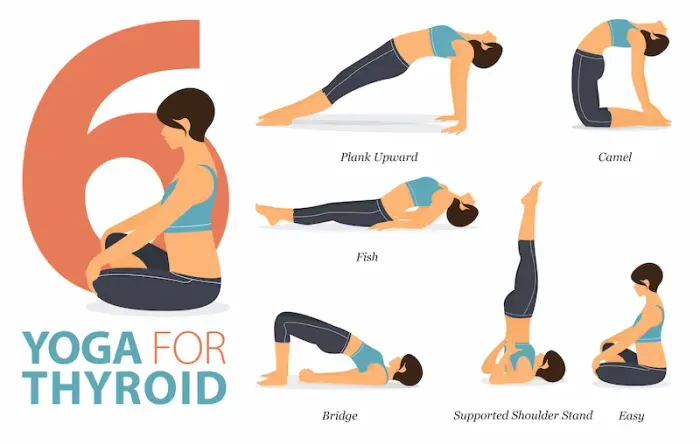Best Yoga Poses for Thyroid Health You Can Practice at Home
Learn safe, effective thyroid yoga poses to do at home. Get step-by-step tips, benefits, and FAQs on yoga for thyroid wellness.

Written by Dr. J T Hema Pratima
Reviewed by Dr. D Bhanu Prakash MBBS, AFIH, Advanced certificate in critical care medicine, Fellowship in critical care medicine
Last updated on 18th Nov, 2025

Introduction
Your thyroid, a small butterfly-shaped gland at the front of your neck, influences almost every part of your body—from energy levels and metabolism to mood, heart rate, and temperature regulation. Many people live with thyroid conditions such as hypothyroidism (underactive thyroid) or hyperthyroidism (overactive thyroid), both of which can affect daily life. While medical treatment is essential, integrating yoga for thyroid health can enhance your overall wellness by reducing stress, improving flexibility, and promoting relaxation.
This guide explores how yoga supports thyroid well-being, provides step-by-step thyroid yoga poses, and outlines a simple home sequence you can safely begin today.
Important: Yoga cannot replace medical care or alter thyroid hormone levels directly. Always continue prescribed treatments and consult your healthcare professional before starting new exercises—especially if you’re pregnant, have a thyroid eye condition, or live with high/low blood pressure, neck or spine issues, or heart problems.
How Yoga for Thyroid Supports Everyday Wellness
Find below the yoga techniques for thyroid health in everyday wellness:
Stress Relief and Relaxation
- Yoga blends gentle movement with mindful breathing, helping calm the body’s stress response.
- Reduced stress can improve sleep quality, mood, and energy balance—all important for people managing thyroid conditions.
Gentle Physical Activity
- Regular movement supports cardiovascular health, flexibility, balance, and mental clarity.
- Global health guidelines recommend 150–300 minutes of moderate-intensity activity weekly, plus muscle-strengthening activities on at least two days, adjusted for your health status.
Consult a Top General Practitioner for Personalised Advice
Neck, Shoulder, and Chest Mobility
- Many thyroid yoga poses involve the upper body, easing tension in the neck, shoulders, and chest—common areas of stiffness or postural strain.
Mind–Body Connection
- Regular practice fosters self-awareness, helping you notice shifts in energy, mood, or symptoms—useful insights to share with your clinician.
Safety First: When to Check with a Clinician
Consult a healthcare professional before starting if you:
- Have uncontrolled hyperthyroidism, a large goitre, or thyroid eye disease.
- Live with neck, spine, or shoulder pain, heart disease, glaucoma, or blood pressure problems.
- Are you pregnant, recovering from surgery, or new to exercise?
General Safety Tips
- Move slowly and avoid pain or forcing your neck into extreme positions.
- Skip or modify inversions (like headstand or shoulderstand) and deep backbends unless cleared by a qualified instructor and your doctor.
- Stop immediately if you feel dizzy, short of breath, chest pain, or any unusual sensations.
Simple Breathing and Warm-Up Routine
Before beginning, try this brief 2–3 minute warm-up:
1.Seated or Standing Diaphragmatic Breathing
- Place one hand on your chest and one on your belly.
- Inhale through your nose, letting the belly gently expand.
- Exhale slowly. Repeat for 6–8 slow breaths.
2.Shoulder Rolls and Neck Mobility
- Roll shoulders forward and back 5–8 times.
- Gently tilt one ear toward the shoulder for 2–3 breaths per side.
- Slowly turn your head left and right without strain.
Best Thyroid Yoga Poses for Home Practice
Each of these beginner-friendly thyroid yoga poses supports relaxation and gentle movement. Hold for 30–60 seconds or several slow breaths.
1) Mountain Pose (Tadasana) with Mindful Breathing
- How: Stand with feet hip-width apart, arms by your sides. Lengthen the spine, soften knees, and relax your shoulders.
- Why: Builds postural awareness, steadies breathing, and centres the mind.
- Try: 5–10 calm breaths.
2) Cat–Cow (Marjaryasana–Bitilasana)
- How: Begin on hands and knees. Inhale as you lift your chest and tailbone (Cow), exhale as you round your spine and tuck your chin (Cat).
- Why: Gently warms the spine and neck, enhancing flexibility.
- Try: 6–8 rounds, synchronising breath and movement.
3) Child’s Pose (Balasana)
- How: From all fours, sit back toward your heels, resting your forehead on the mat or a pillow.
- Why: Promotes relaxation and releases tension in the back, shoulders, and throat.
- Modify: Place a cushion between the hips and heels if needed.
4) Sphinx or Low Cobra (Salamba Bhujangasana/Bhujangasana)
- How: Lie on your stomach. For Sphinx, rest forearms on the floor; for Low Cobra, place hands under shoulders and lift chest slightly on the inhale.
- Why: Opens the chest and front body, aiding deeper breathing.
- Caution: Keep the backbend mild; avoid if lying on your stomach feels uncomfortable.
5) Supported Bridge Pose (Setu Bandha Sarvangasana)
- How: Lie on your back, knees bent, feet hip-width. Press feet to lift hips slightly, placing a yoga block or firm pillow under the lower back.
- Why: Gently opens the chest and shoulders, fostering calm.
- Caution: Keep your neck neutral, gaze straight up.
6) Supported Fish Pose (Matsyasana), Gentle Version
- How: Place a folded blanket under your upper back and another under your head. Lie back with arms relaxed by your sides.
- Why: Encourages deep breathing and opens the chest comfortably.
- Modify: Adjust props to avoid any neck or throat pressure.
7) Seated Neck Stretches
- How: Sit upright. Tilt your right ear toward your right shoulder for 3–5 breaths, then switch. Turn your head gently to look over each shoulder.
- Why: Relieves daily tension and stiffness around the neck.
8) Legs Up the Wall (Viparita Karani)
- How: Sit sideways close to a wall, lie back, and raise your legs up against the wall. Adjust distance for comfort.
- Why: Calming pose that helps with relaxation and circulation.
- Caution: Avoid if you have uncontrolled high blood pressure or glaucoma.
9) Low Lunge with Heart Opening (Anjaneyasana)
- How: From all fours, step the right foot forward, hands resting on the front thigh. Lift the chest softly, keeping the neck long.
- Why: Opens hips and chest, promoting posture and breath awareness.
- Modify: Use blocks under hands for stability.
10) Reclined Spinal Twist (Jathara Parivartanasana)
- How: Lie on your back, bend your knees, and gently drop them to one side while extending your arms in a T-shape.
- Why: Eases tension in the lower back and calms the nervous system.
- Caution: Keep twists gentle and avoid any discomfort.
A 15-Minute At-Home Thyroid Yoga Sequence
A short, restorative routine perfect for daily use includes:
- 1 minute: Seated diaphragmatic breathing.
- 2 minutes: Cat–Cow (6–8 rounds) → Child’s Pose (5–8 breaths).
- 2 minutes: Sphinx or Low Cobra (3–4 lifts) → brief rest.
- 2 minutes: Low Lunge (right and left, 4–5 breaths per side).
- 2 minutes: Seated Neck Stretches (side bends and rotations).
- 3 minutes: Supported Bridge or Supported Fish with steady nasal breathing.
- 3 minutes: Legs Up the Wall or Reclined Twist, ending with 3–5 deep breaths lying on your back.
How Often Should You Practise?
The frequency of practice includes:
- Aim for 10–20 minutes, 3–5 days per week, adjusting based on energy levels.
- On low-energy days, focus on restorative poses like Child’s Pose or Legs Up the Wall.
- On better days, extend holds or add rounds gradually.
Practical Tips to Build a Habit
Practical tips to build a habit include:
- Pair your yoga time with an existing daily routine (after waking or before bed).
- Keep props nearby—a pillow, folded blanket, or yoga block.
- Track your progress by noting mood, energy, or sleep changes after each session.
- Create a calm, quiet environment with gentle lighting or soothing music.
What Yoga Can and Cannot Do for Thyroid Health
Let us see what yoga can and cannot do for thyroid health:
What It Can Do
- Reduce stress and support emotional balance.
- Improve posture, flexibility, and body awareness.
- Encourage consistent physical activity aligned with health goals.
- Complement medical care by enhancing general well-being.
What It Cannot Do
- Replace prescribed thyroid medications or medical procedures.
- Directly change thyroid hormone levels or cure thyroid disease.
- Serve as a standalone treatment—medical supervision remains essential.
Conclusion
Yoga for thyroid health provides a gentle, accessible way to manage stress, improve posture, and nurture body awareness. Regular practice enhances relaxation, helps maintain mobility, and supports emotional balance—valuable for anyone living with thyroid conditions. Remember, yoga is most effective as a complement to professional care, not a replacement. Start slowly, breathe deeply, and listen to your body. With consistency and mindfulness, you can create a balanced routine that supports both your thyroid and overall well-being.Consult a Top General Practitioner for Personalised Advice
Consult a Top General Practitioner for Personalised Advice

Dr. Anand Ravi
General Physician
2 Years • MBBS
Bengaluru
PRESTIGE SHANTHINIKETAN - SOCIETY CLINIC, Bengaluru

Dr Syed Mateen Pasha
General Physician
2 Years • MBBS
Bengaluru
PRESTIGE SHANTHINIKETAN - SOCIETY CLINIC, Bengaluru

Dr. Syed Ismail Ali
General Practitioner
7 Years • MBBS
Hyderabad
Apollo 24|7 Clinic, Hyderabad

Dr. Johnson. S
General Practitioner
7 Years • MBBS MD(Preventive and social Medicine)
Pune
Apollo Clinic, Nigdi, Pune

Dr. Madhuri Sai Sreepada
General Practitioner
9 Years • MBBS
Hyderabad
BRIGHT SMILES MEDICARE & DENTAL CARE, Hyderabad
Consult a Top General Practitioner for Personalised Advice

Dr. Anand Ravi
General Physician
2 Years • MBBS
Bengaluru
PRESTIGE SHANTHINIKETAN - SOCIETY CLINIC, Bengaluru

Dr Syed Mateen Pasha
General Physician
2 Years • MBBS
Bengaluru
PRESTIGE SHANTHINIKETAN - SOCIETY CLINIC, Bengaluru

Dr. Syed Ismail Ali
General Practitioner
7 Years • MBBS
Hyderabad
Apollo 24|7 Clinic, Hyderabad

Dr. Johnson. S
General Practitioner
7 Years • MBBS MD(Preventive and social Medicine)
Pune
Apollo Clinic, Nigdi, Pune

Dr. Madhuri Sai Sreepada
General Practitioner
9 Years • MBBS
Hyderabad
BRIGHT SMILES MEDICARE & DENTAL CARE, Hyderabad
More articles from General Medical Consultation
Frequently Asked Questions
1) Can yoga cure thyroid problems?
No. Yoga helps manage stress, improve flexibility, and boost well-being, but cannot cure thyroid disease. Continue your medical treatment as prescribed.
2) Which poses are best for home practice?
.Gentle, neck-safe poses such as Cat–Cow, Child’s Pose, Supported Bridge, Supported Fish, Seated Neck Stretches, and Legs Up the Wall are ideal for beginners.
3) How often should I do yoga for thyroid support?
Most people benefit from 10–20 minutes of yoga on most days. Focus on consistency rather than intensity and adjust according to your energy levels.
4) Are there poses to avoid?
Avoid or modify strong inversions (headstand, shoulderstand) and deep backbends if you have hyperthyroidism, neck issues, high blood pressure, glaucoma, or are pregnant, unless cleared by a healthcare provider.
5) Can I practise yoga if I take thyroid medication?
Yes. Yoga is generally compatible with thyroid medicines. Continue your medication exactly as prescribed—typically on an empty stomach at the same time daily—and consult your clinician about timing if you practise in the early morning.
Final encouragement
If you’re looking for a gentle, accessible way to support your overall well-being with a thyroid condition, these thyroid yoga poses are a safe place to start. Roll out a mat, move with your breath, and keep your healthcare provider in the loop. With regular practice, yoga for thyroid wellness can become a calming anchor in your day.




